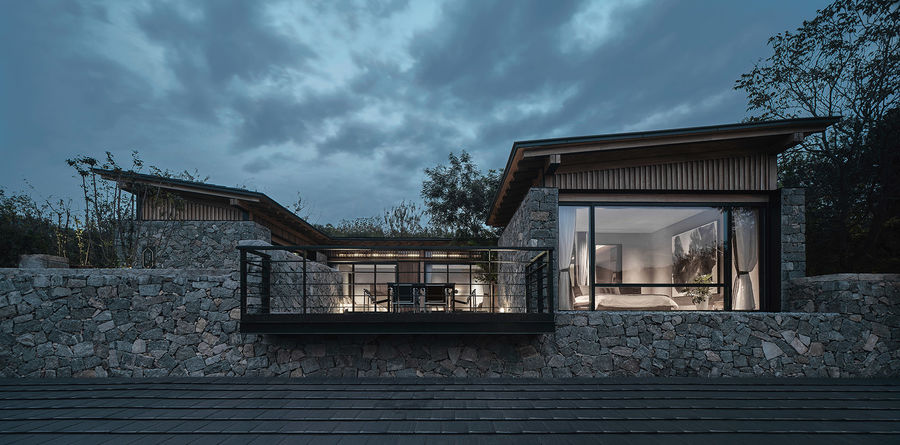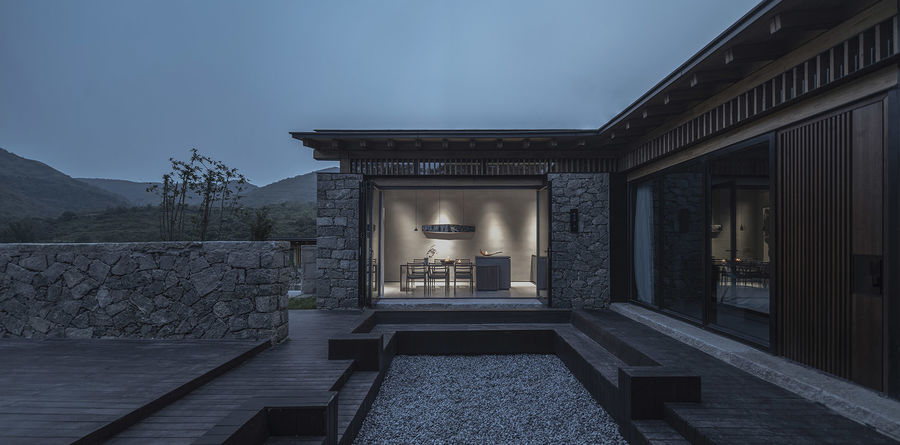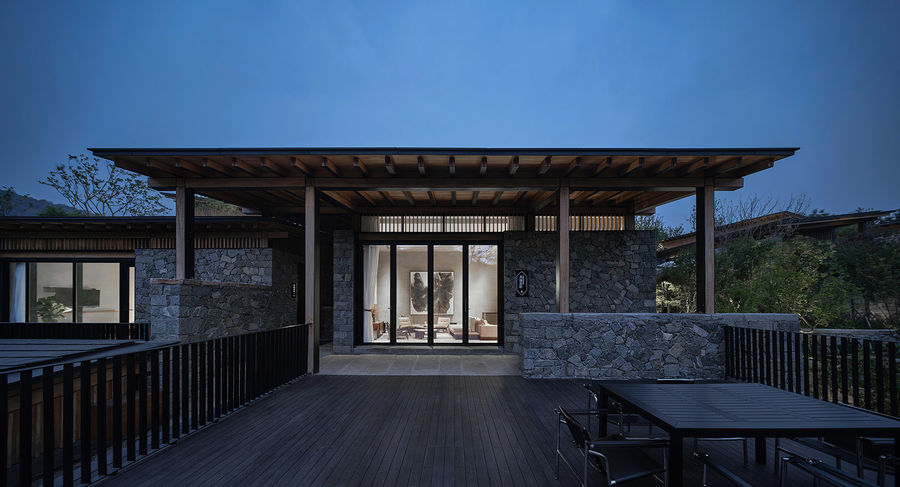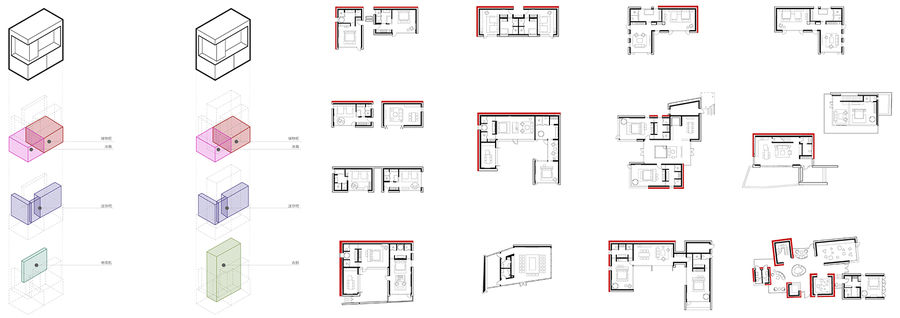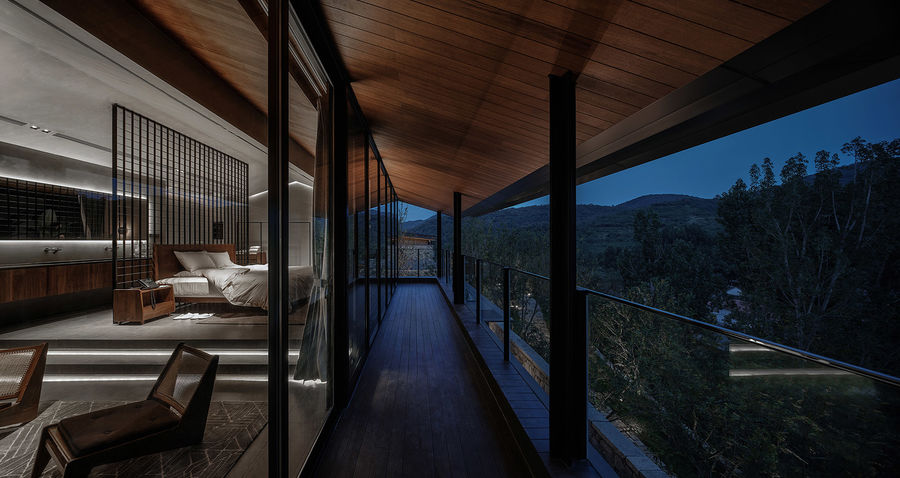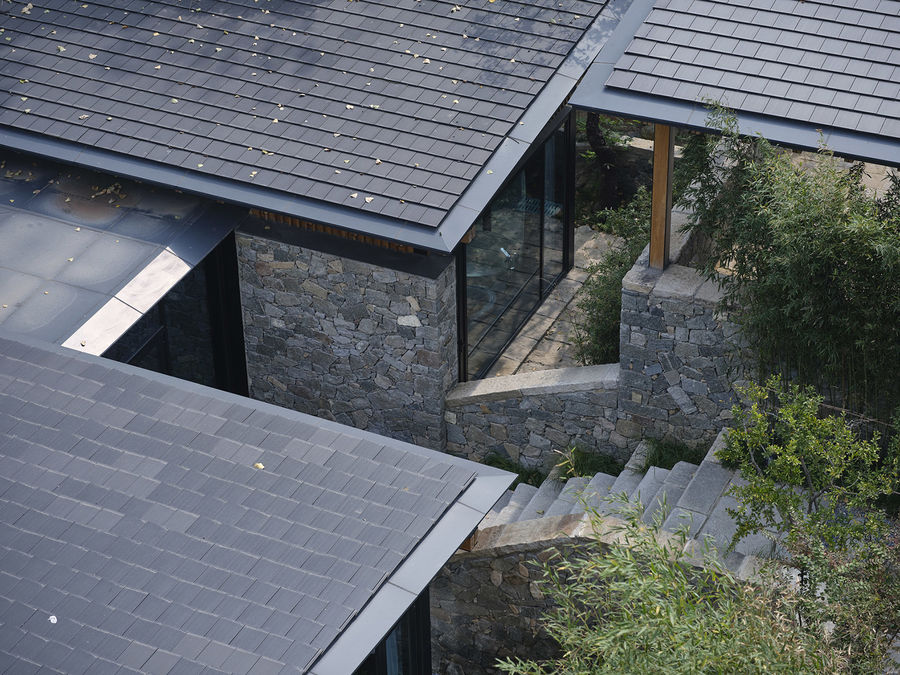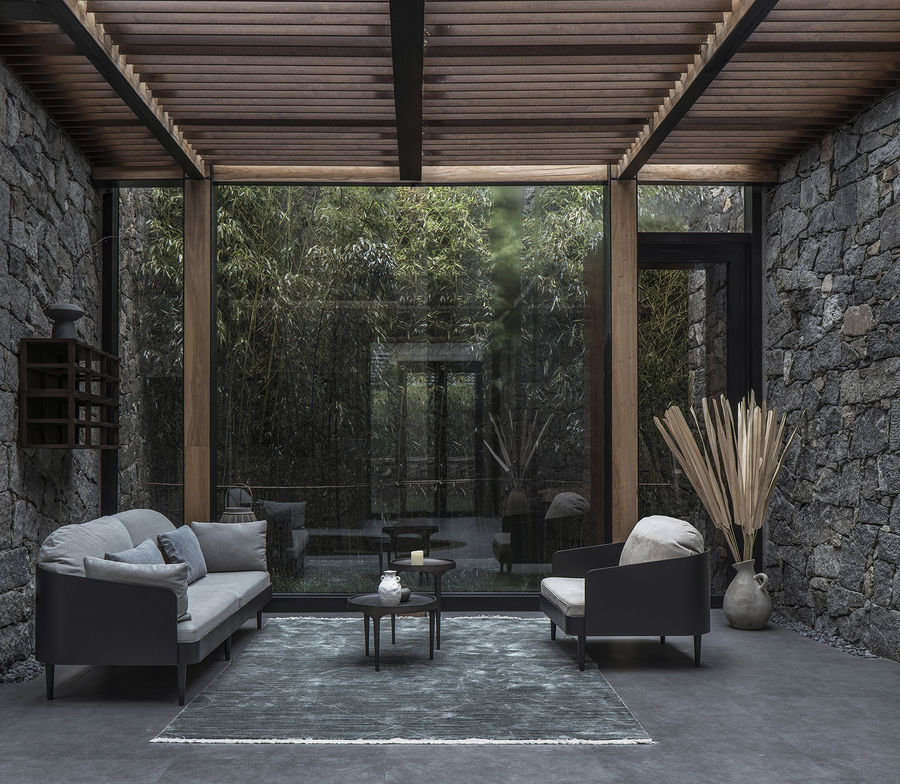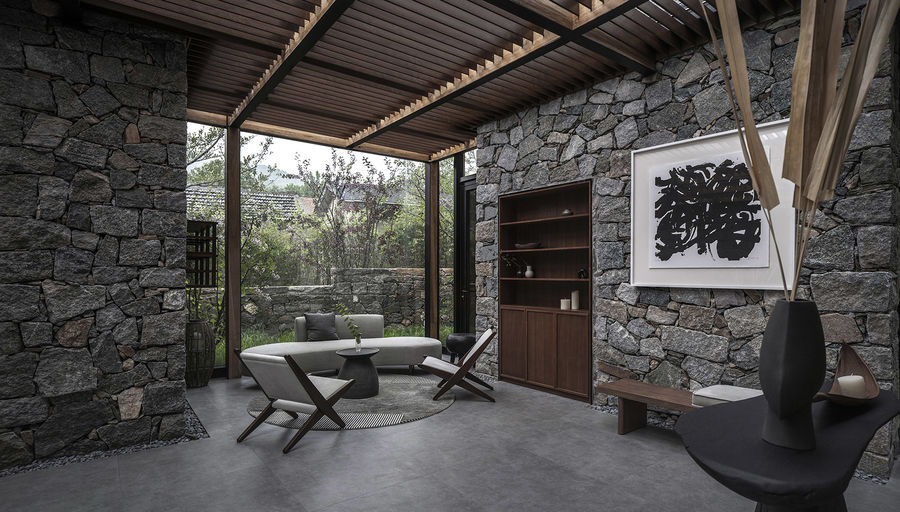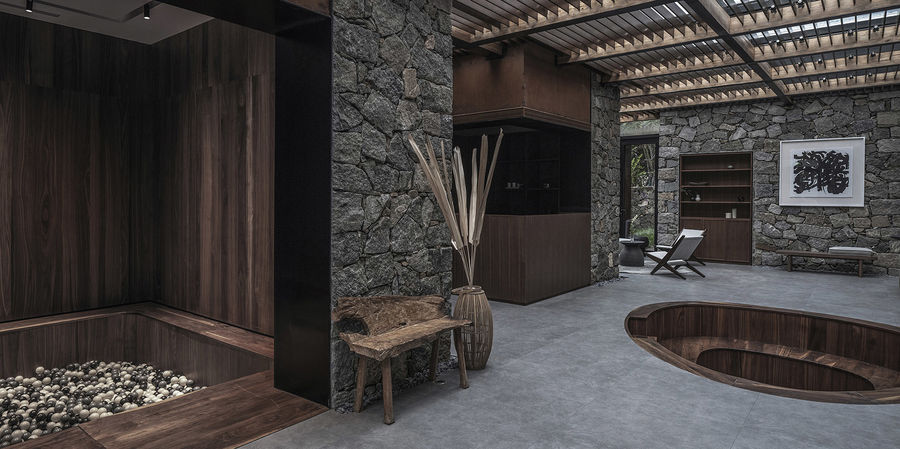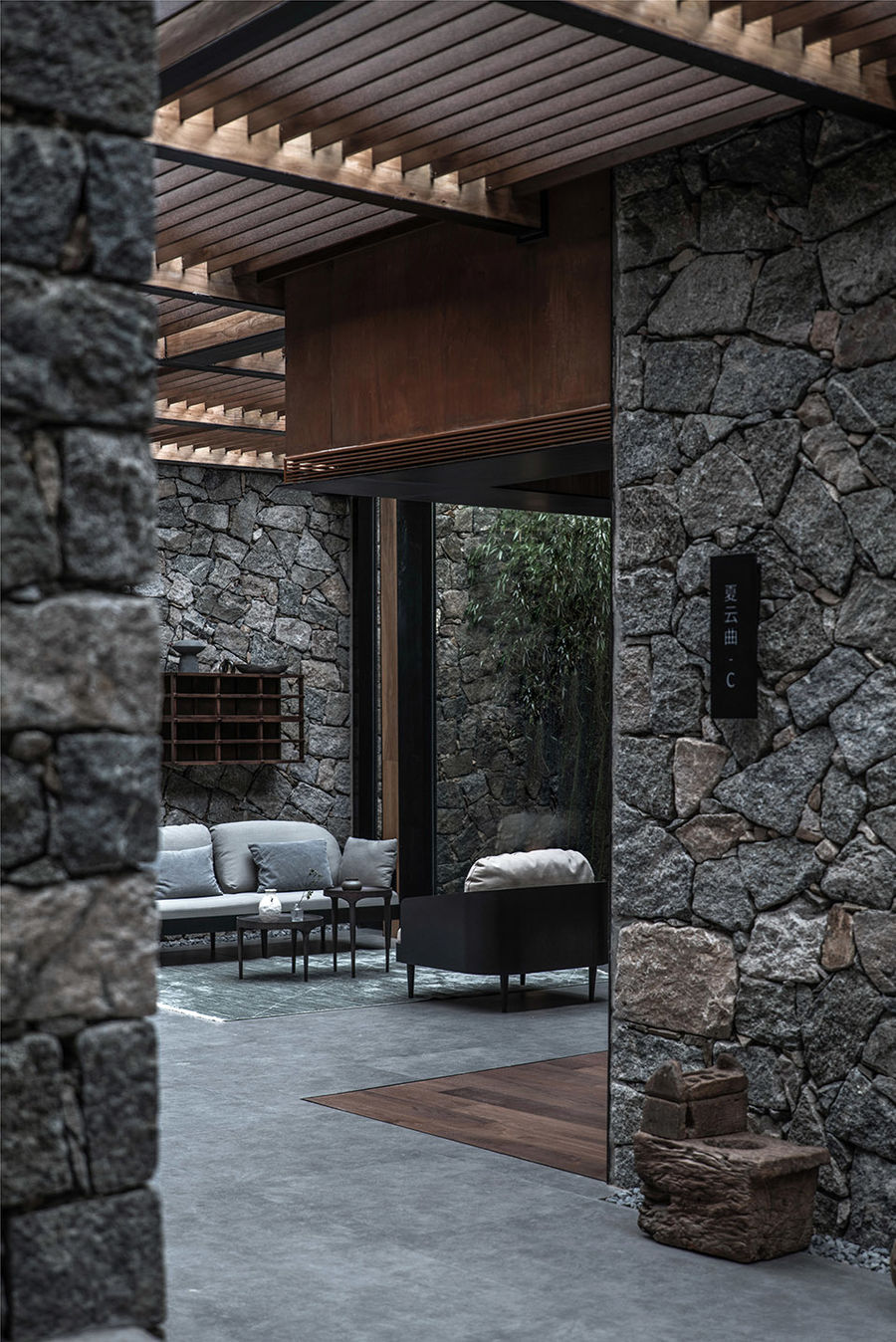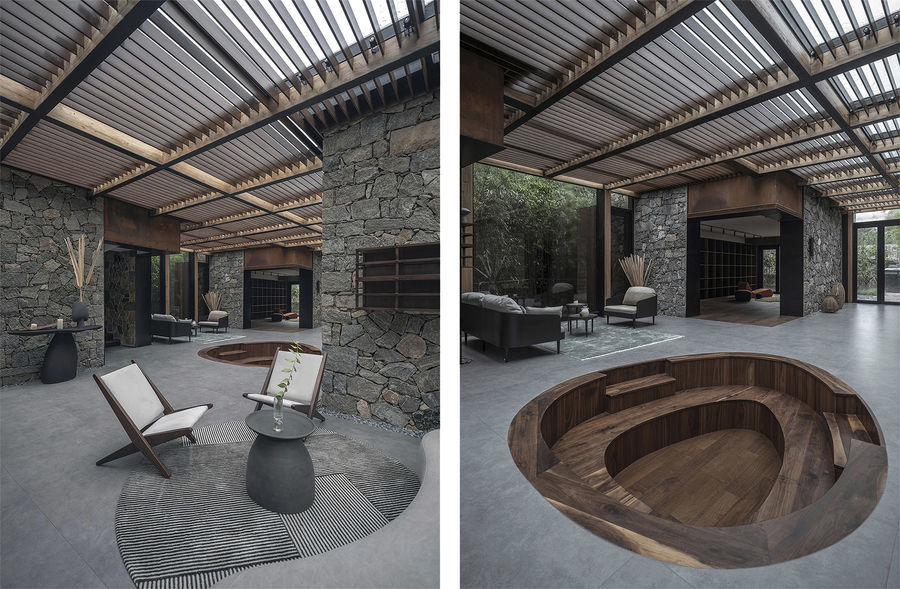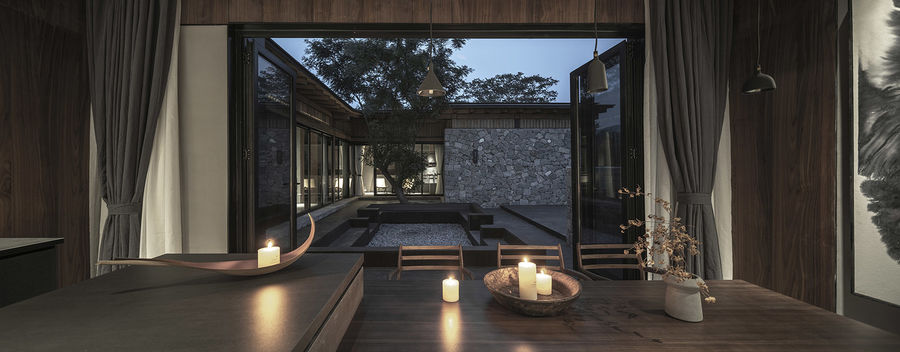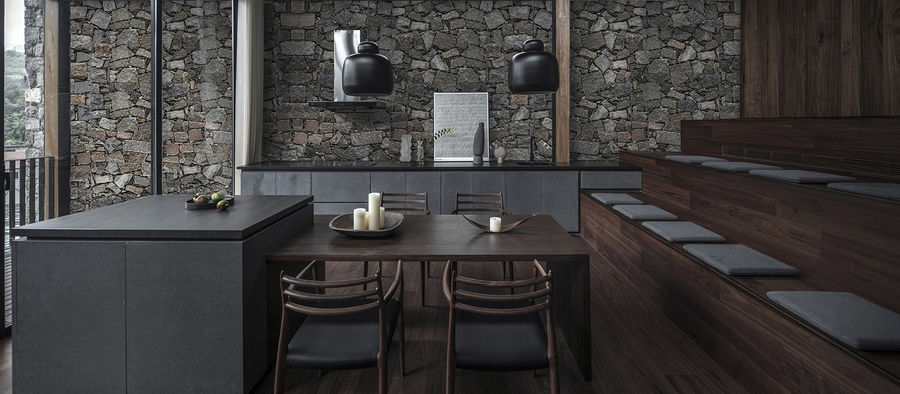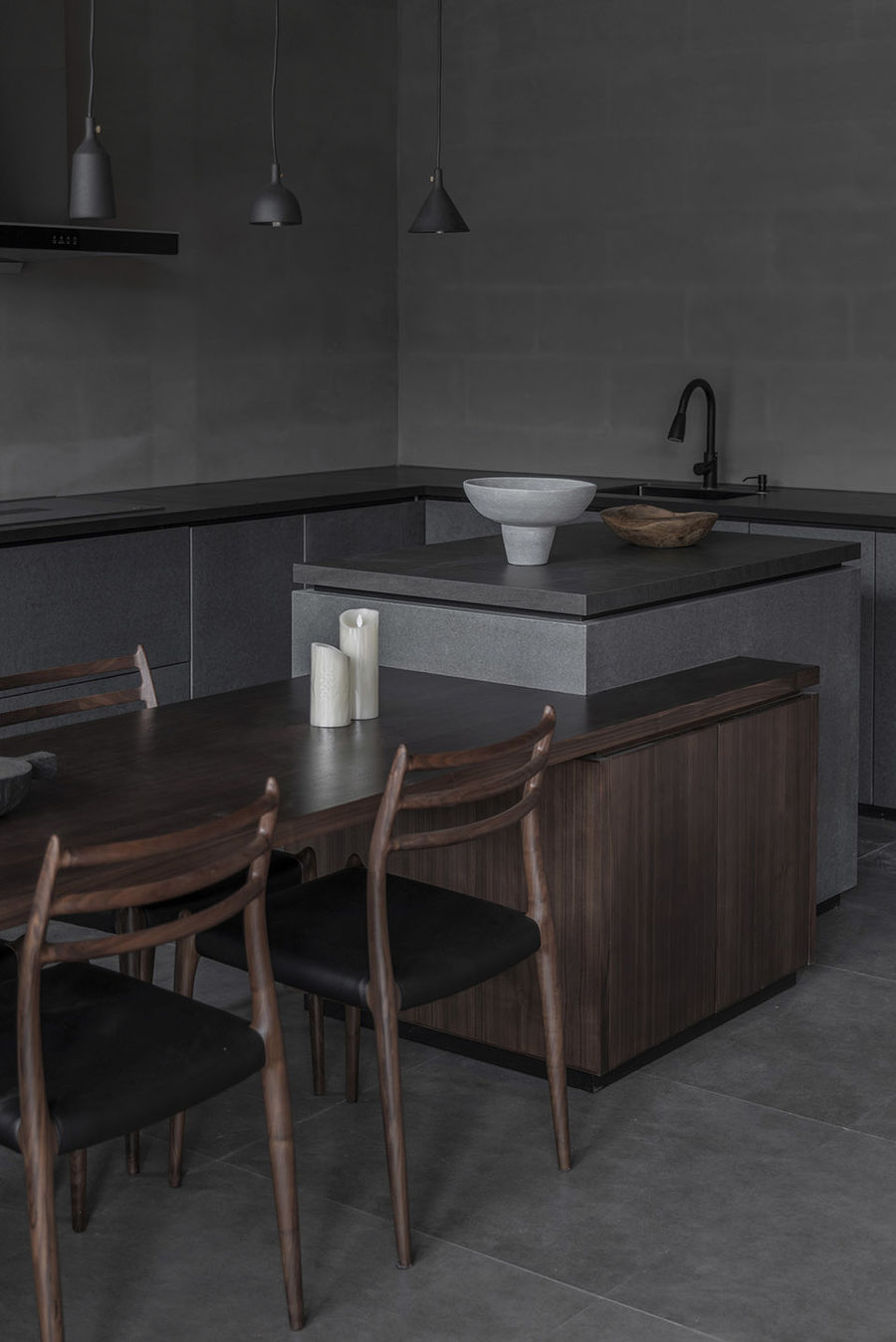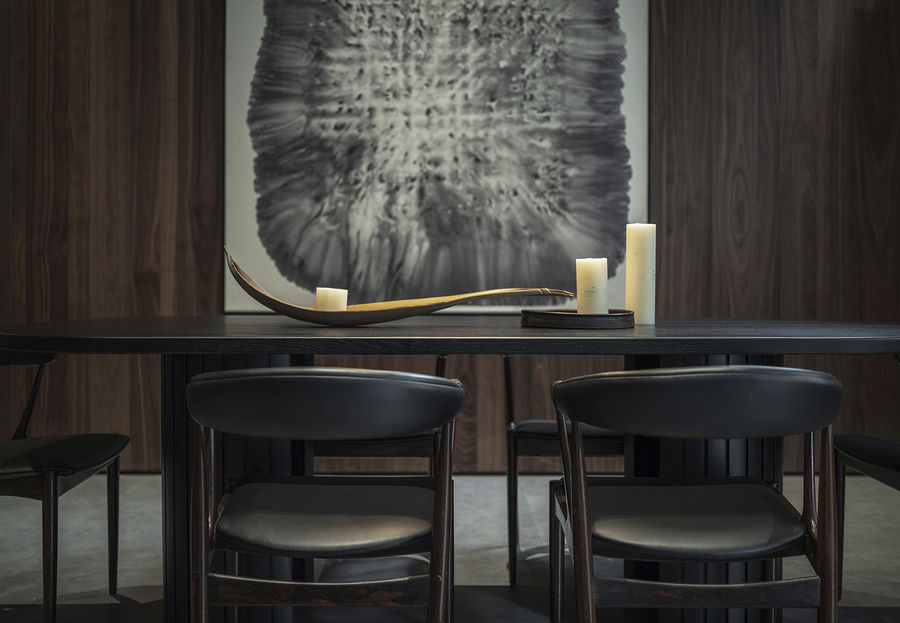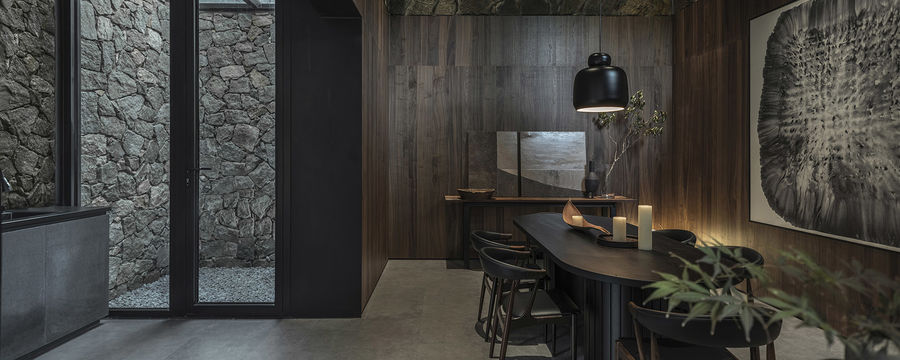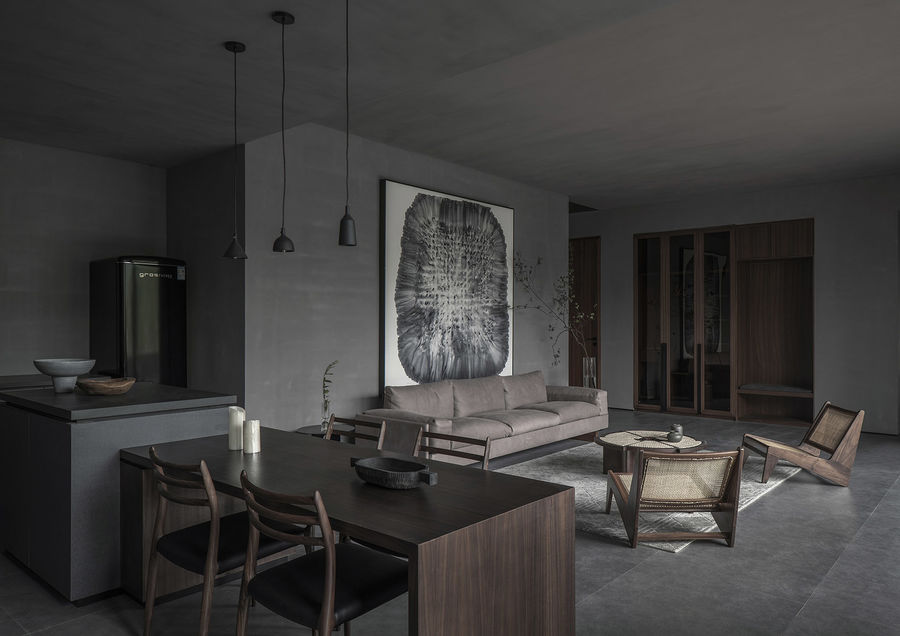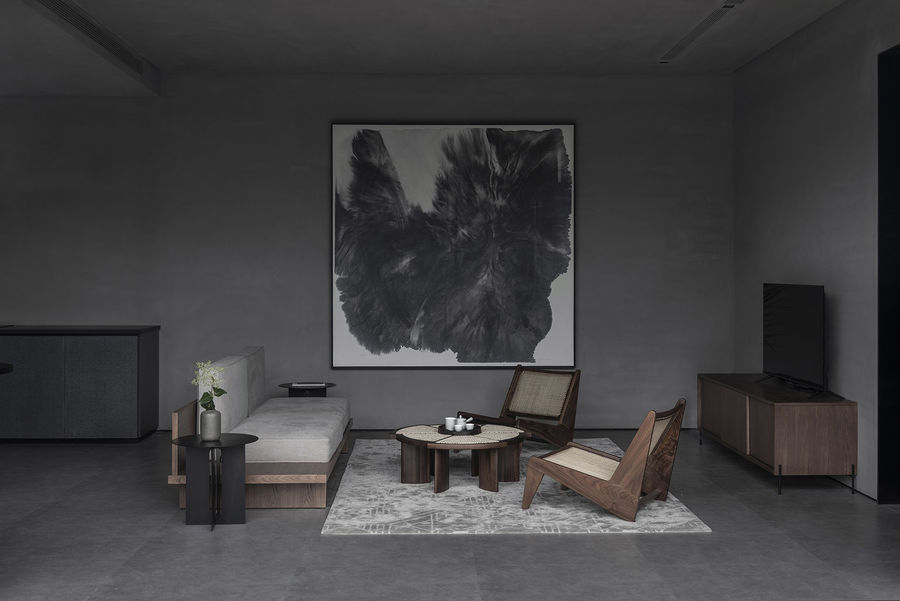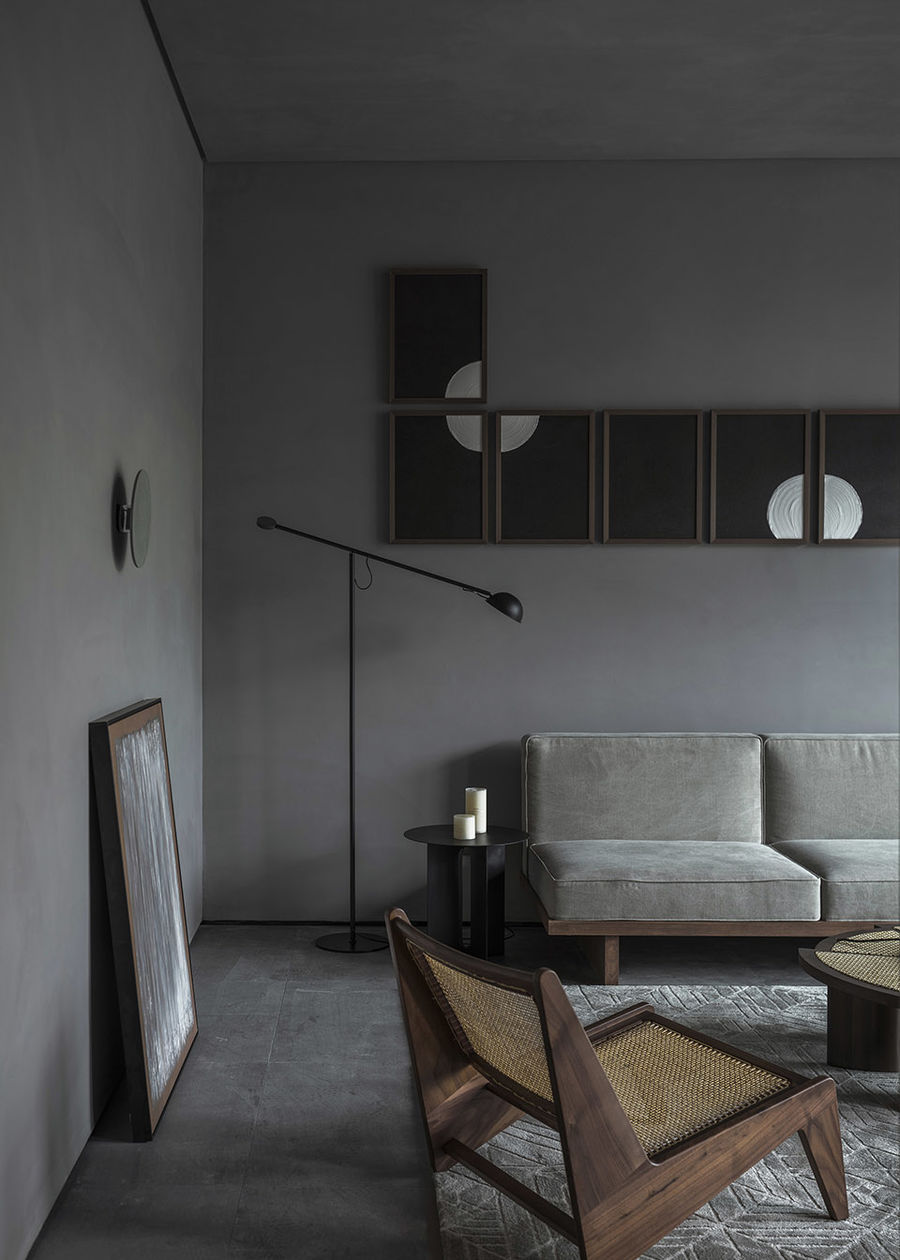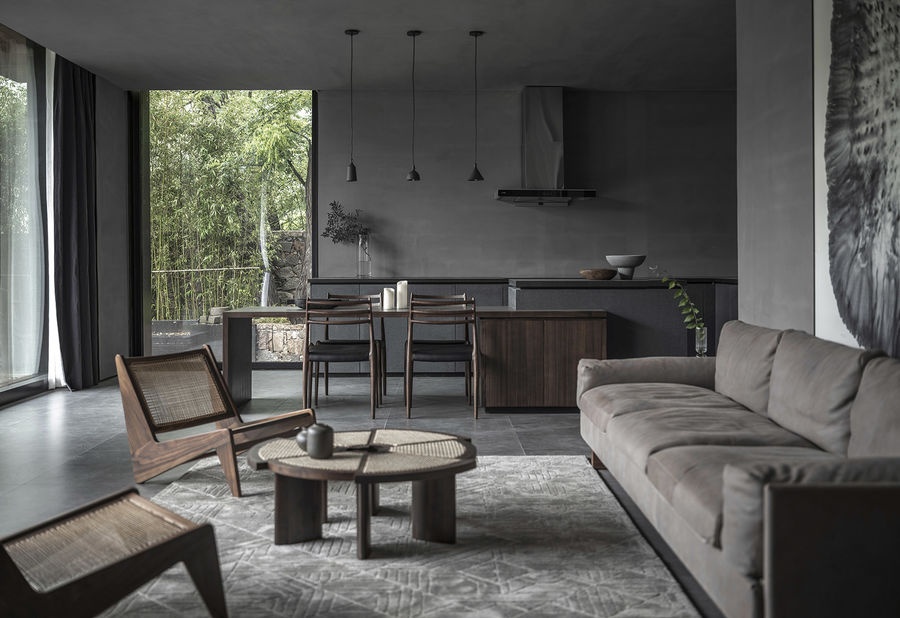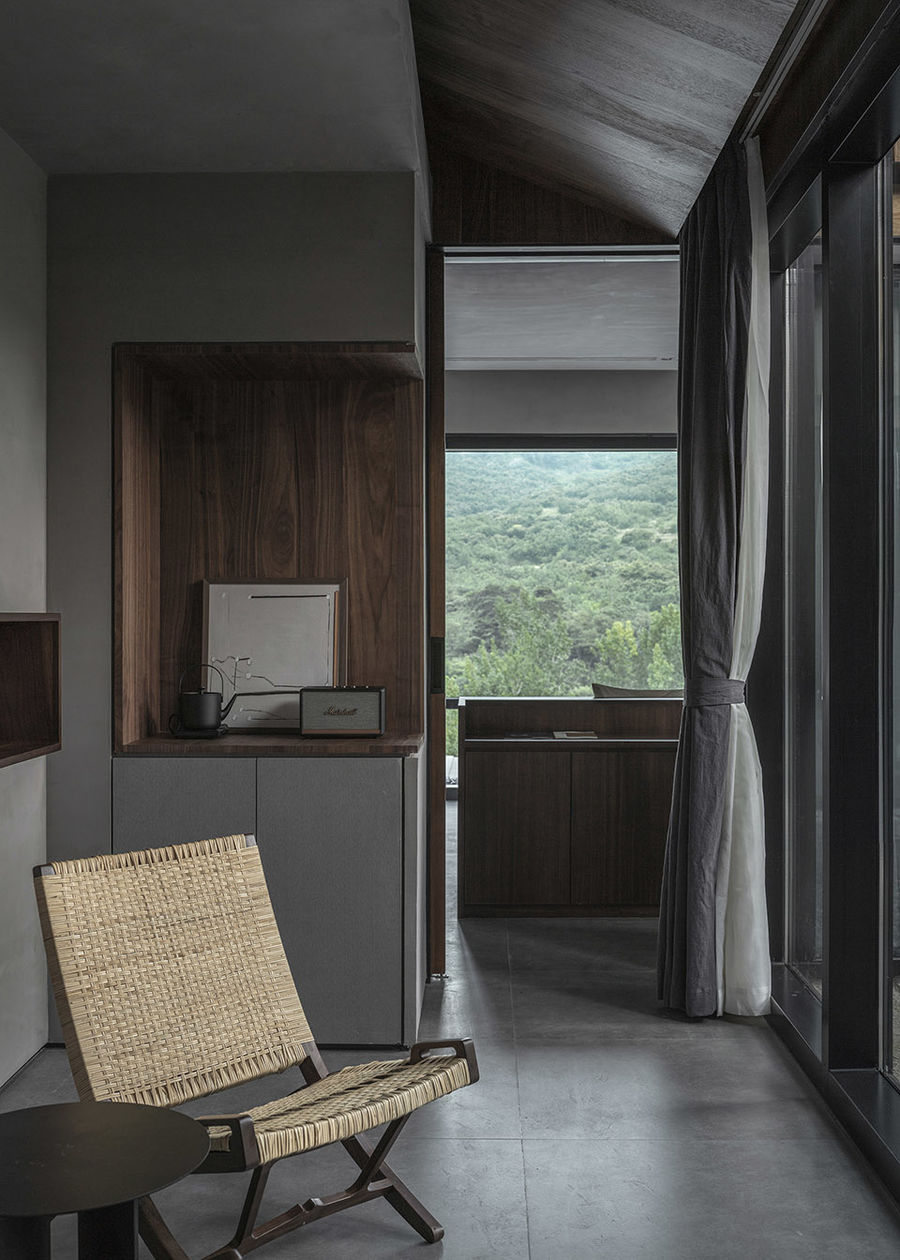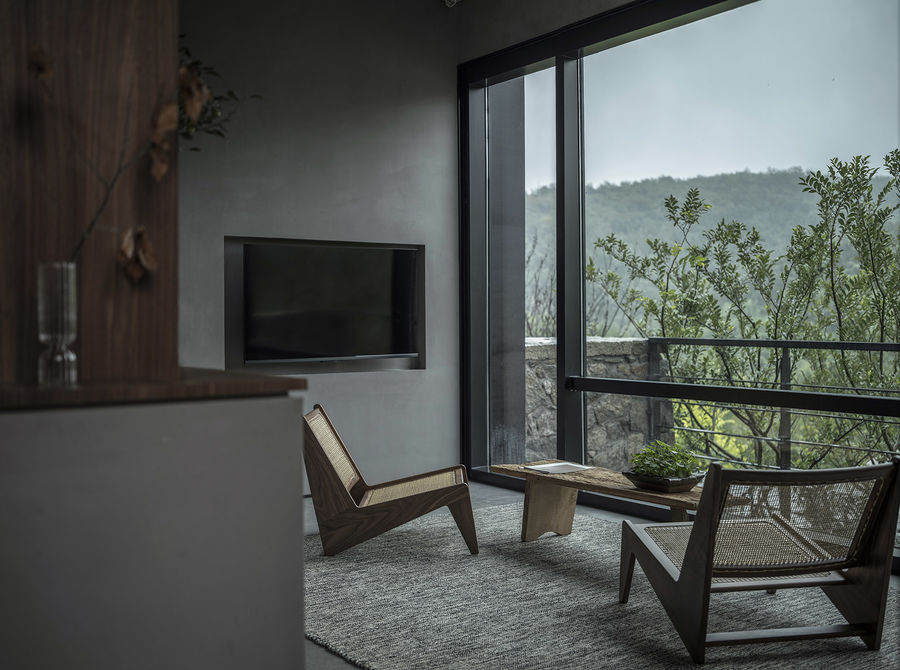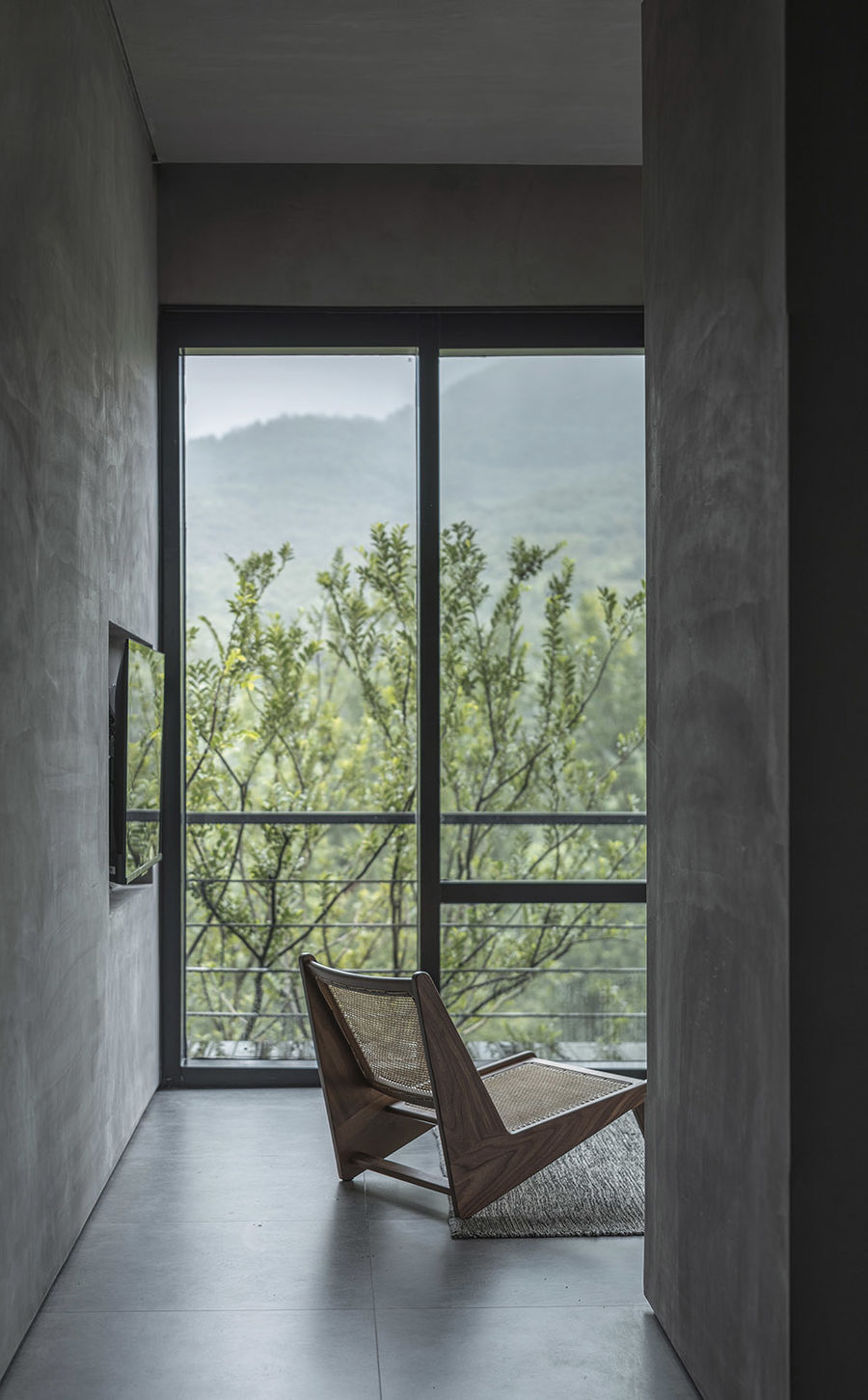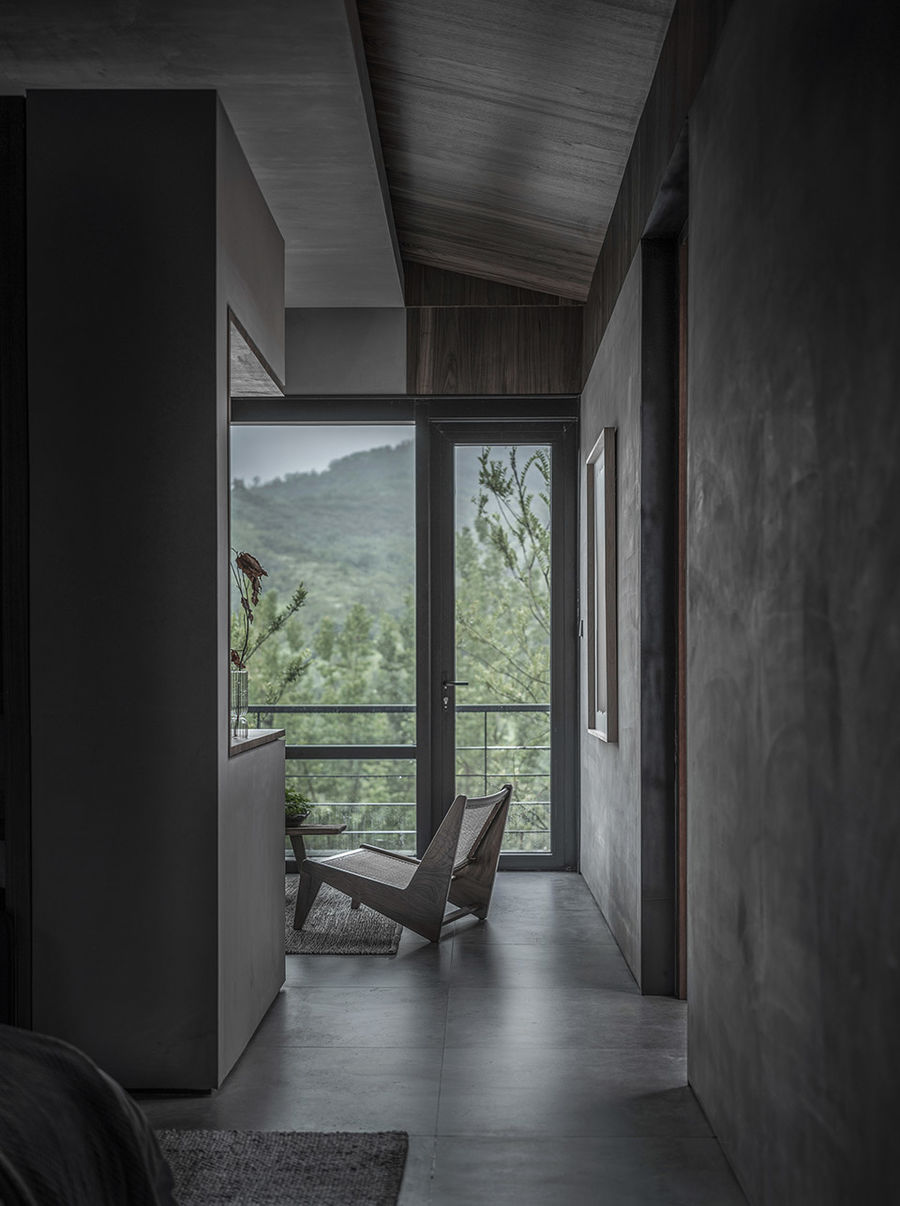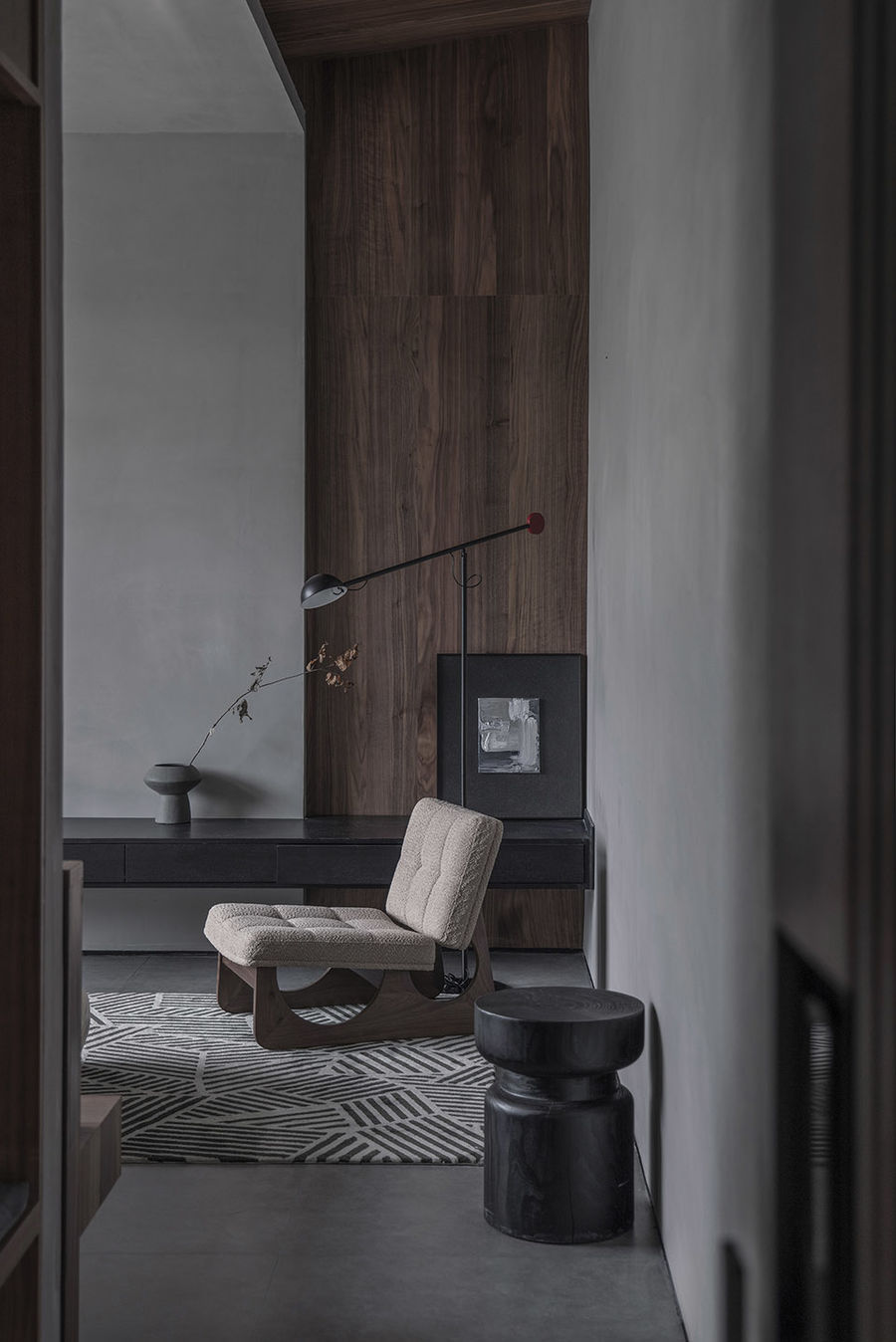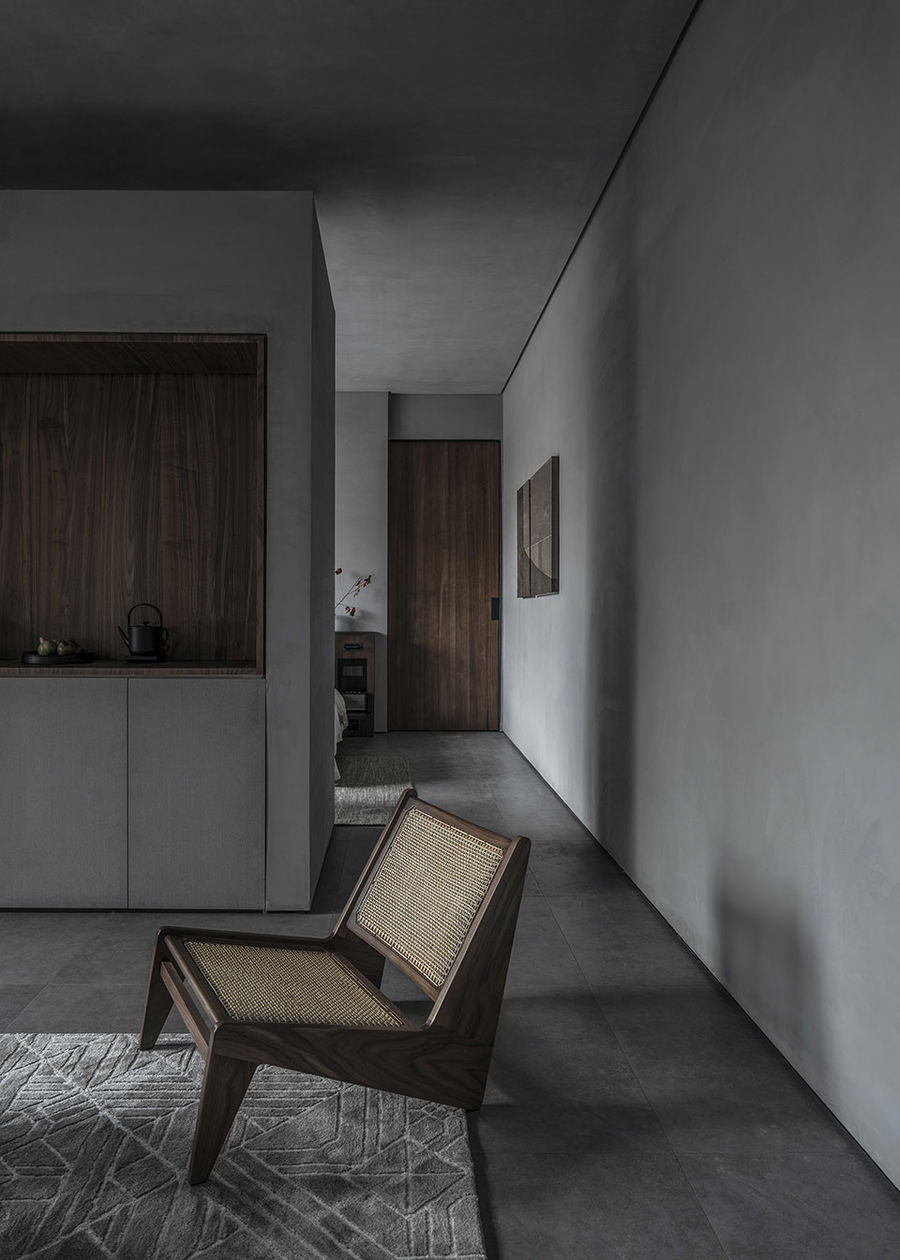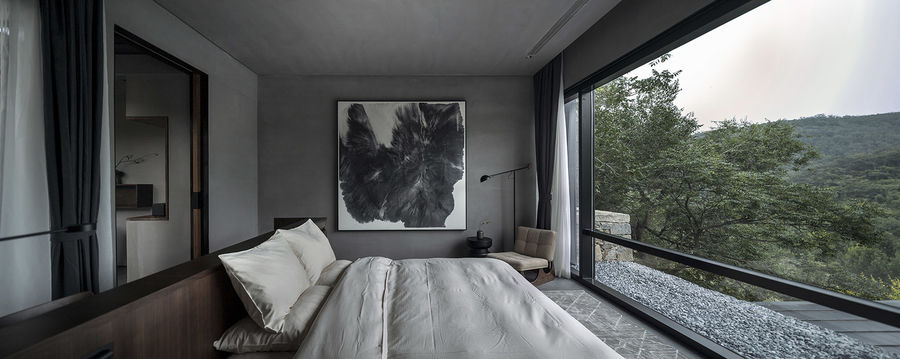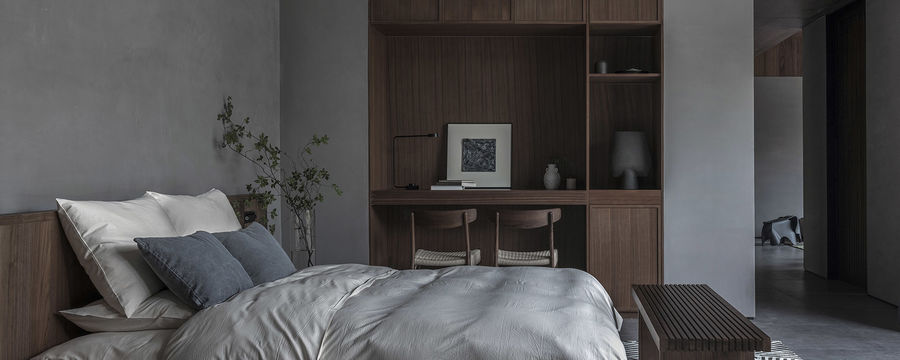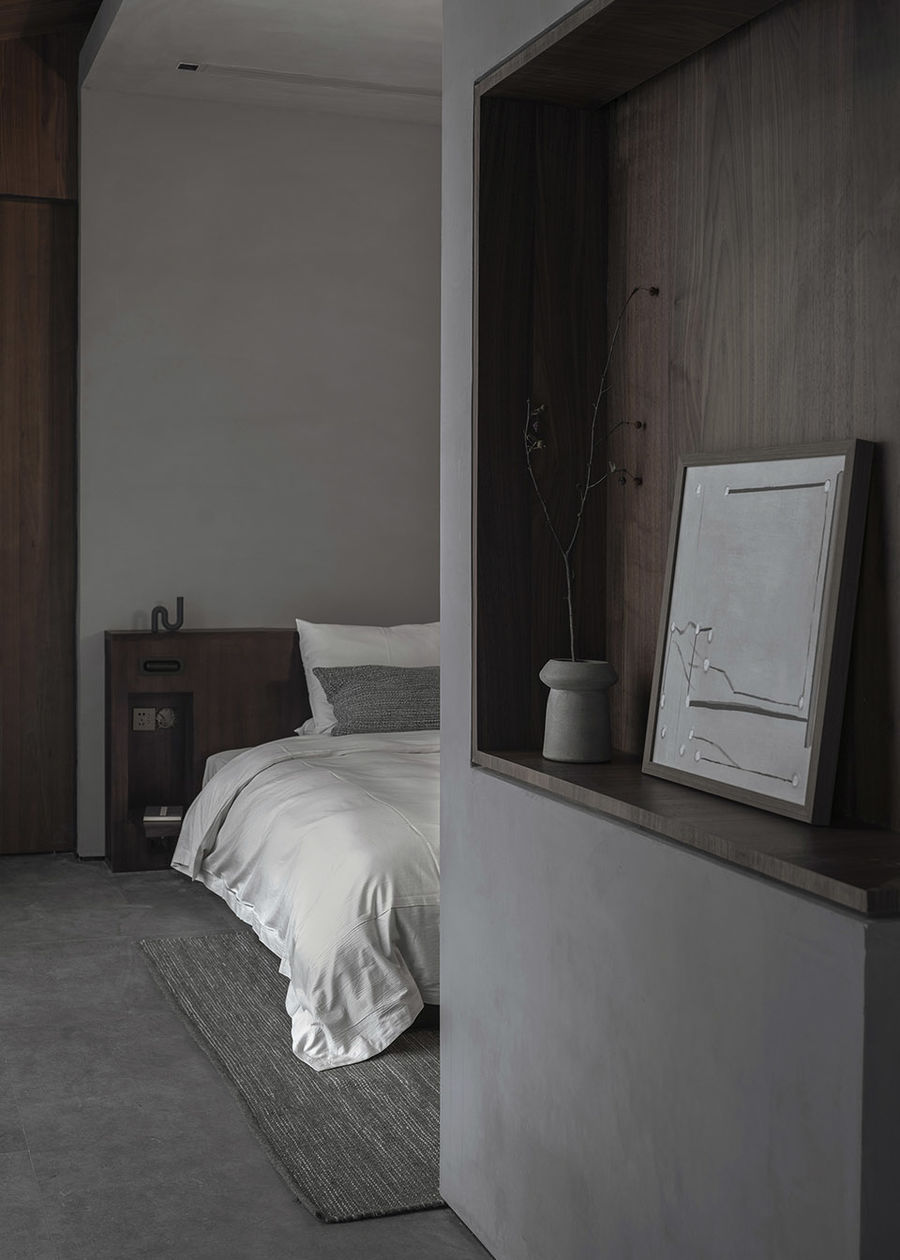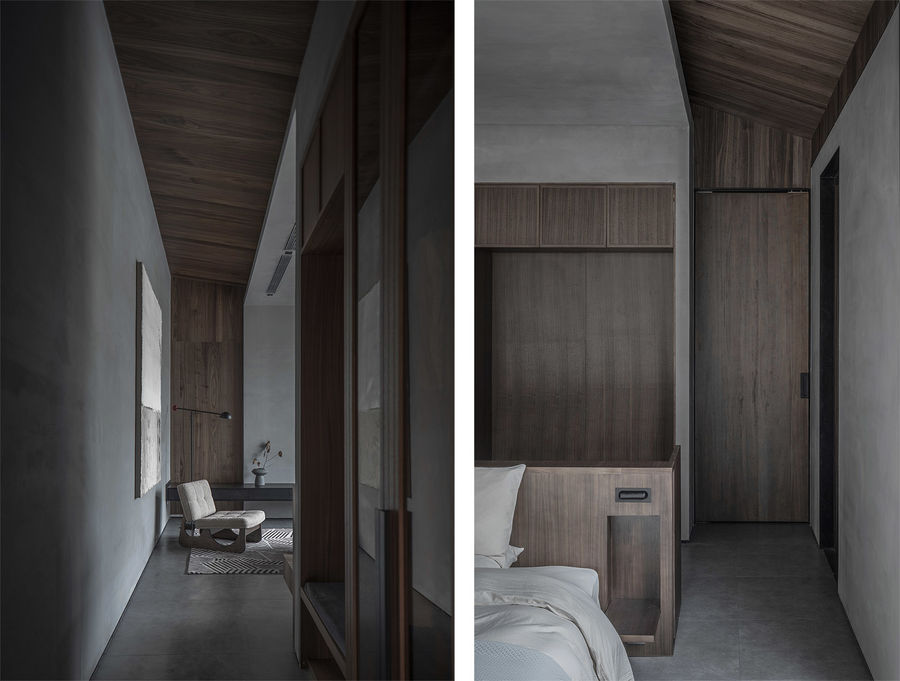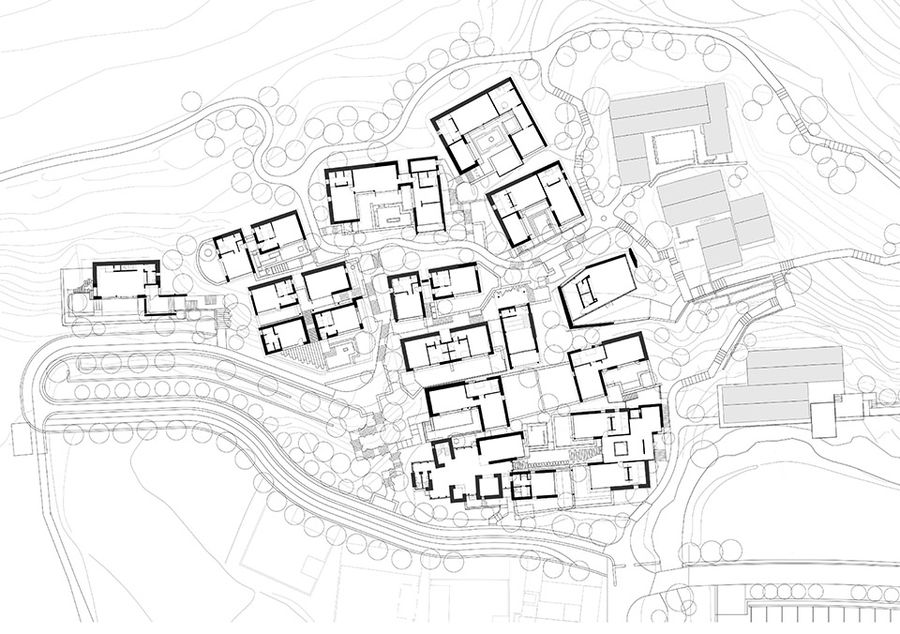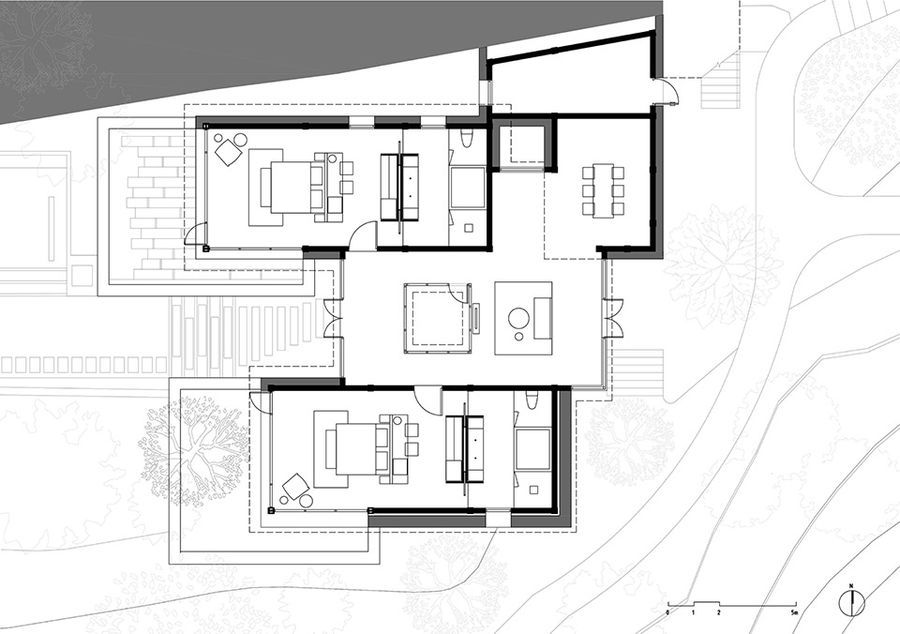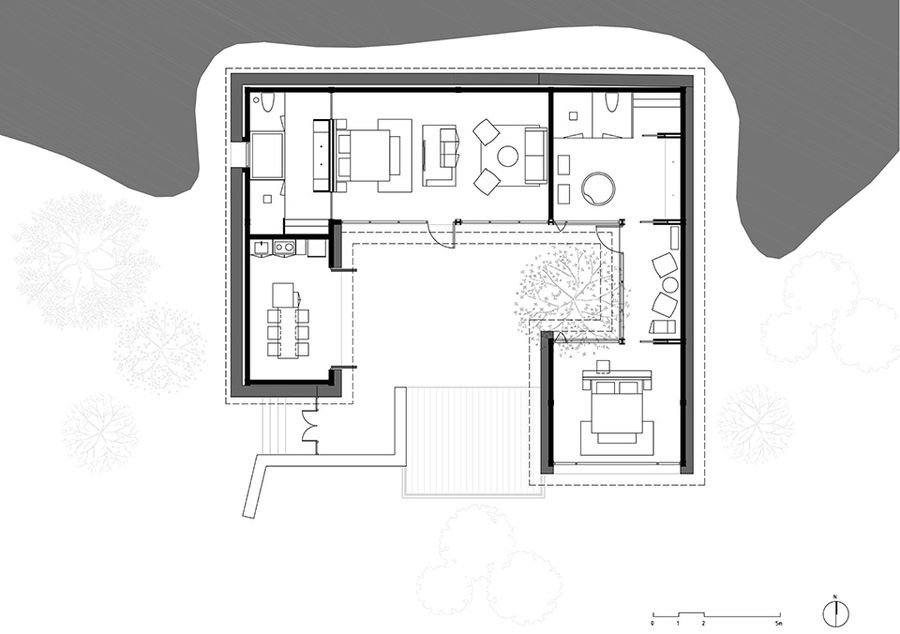泰山九女峰山脉脚下的东西门村依山间溪流展开,相传立村于清朝康熙年间。小乡村在此默默延续了几百年,直至原住民背井离乡,留下村落在山中渐渐衰败。2019年,鲁商集团在此试点乡村振兴,引入朴宿品牌想将破败的村落盘活为高端酒店。我们受此委托,怀着对原始场地的尊重,希望保留百年间人与自然互动的空间记忆,用尽量少的设计手法和材料介入让场地本身的气质自然显露,给逃离喧嚣的人们制造质朴而舒适的休憩空间。
Dongximen Village, established in the Qing Dynasty, is at the foot of the range of Mount Tai. This small village grew silently for hundreds of years, until the villagers left and then gradually declined. In 2019, LuShang Group introduced the Pusu Inn here in an attempt to activate the village as a high-end resort. During the design process, with respect for the original site, we use as little design techniques and materials as possible to naturally reveal the temperament of the site itself.
▼项目外观概览,overall of the exterior appearance ©章鱼见筑
记忆的保留
Retain the Memories
山地的西南角错落地分布着四个由毛石堆砌而成的杂物房。这四个方形体块之间所形成的空间关系是村民生活和自然山体不断对话的结果。我们对这几个早已破败的杂物房进行了原址修复,在顶面和墙面采用玻璃封闭空间以形成日光中庭,最大程度保留原始的场地肌理的同时强调了建筑的体积感。传统定义的内立面外立面在此不复存在,中庭空间所拥有的是户外的场所感。同时,玻璃的工业感则突出了毛石的质朴粗矿和蕴藏其间石匠工人的传统手艺。
In the southwest corner, there were four utility rubble rooms. The relationship between them was the result of continuous change between the villagers’ life and the natural mountain. We renovated these long run-down rooms on the original scope, and establish a sunlight atrium by the glass roof to preserve the site texture and emphasize the building volume. There is no traditionally defined internal and external façade, and the atrium is also the outdoor activity space. At the same time, the industrial glass and traditional handmade rubble complement each other.
▼保留原始的场地肌理的同时强调了建筑的体积感,preserve the site texture and emphasize the building volume ©章鱼见筑
每个体块在角部打开,通过耐候钢板和黑色钢板的组合将开口凸显。接待、儿童活动室、泡泡池、楼梯等功能由此融入整个中庭。建筑体块的独立性和内部空间的完整性这对矛盾在此得到了完美的解决。场地中央原本留存的坑洞被改造成台阶式的下沉庭院,为中庭增添灵动的同时形成向心性。体块之间自然围合出稳定的区域,外部景观则透过玻璃蔓延进来,此间设置沙发,供茶歇休憩。修缮后的石头盒子将一直默默承载着村落的记忆,与在内嬉戏玩耍的孩子们一起,将时间延续。Each volume is opened at a corner, and the opening is highlighted by the weather-resistant steel plate and black steel plate. The reception, children’s activity room, bubble pool and stairs are led into the atrium. The independence of the building block and the integrity of the internal space are simultaneously reflected. The original pothole in the center of the site was renovated into a stepped sunken courtyard, making it flexible and stable. And set a sofa there for the visitors to enjoy the natural view from the generous glass. The renovated stone houses with changing functions will always silently carry the memory of the village.
▼台阶式的下沉庭院,stepped sunken courtyard ©潘杰
传统的更新
Renew the Traditions
村落的民居院落多分布在山坡陡地,以L型院与三合院为主。原住民早已搬离而房屋则呈衰败之势。但即使残破,院落和自然山体所呈现的高度融合依旧保存着曾经的生活记忆。我们的客房即从这些原始院落脱胎而来。
The residential courtyards of the village are mostly distributed on steep hillsides, mainly L-shaped courtyards and three-section compounds with natural resources and old life memory. All the guest rooms are born out of these declining courtyards.
▼分析图,diagram © gad · line+ studio
我们保留老院落的原始肌理及空间关系,强化景观的导入和内院的核心性。以此为基础进行适当扩建,将客房及公共活动的功能以组团方式置入。那些保留的毛石墙和重建的毛石墙见证了新与旧的传承。平面组织和功能排布依据每个院子各异的地形高差、方位朝向及最为重要的原始肌理而定制。人们在此不仅体验高品质的度假感受,更能和传统相通。We retained the original texture and spatial relationship, and strengthened the introduction of the landscape and the centricity of the inner courtyard, based on which, incorporated the functions of guest rooms and public activities in groups. Those preserved rubble walls and reconstructed rubble walls have witnessed the heritage of the new and the old. Operating the floor plan, functions, terrain and orientation, make every building out of the ordinary. Visitors can not only enjoy high-quality vacation experience here, but also communicate with traditions.
▼毛石墙见证了新与旧的传承,reconstructed rubble walls have witnessed the heritage of the new and the old
化繁为简–空间处理手法
Less is More – Space Processing Techniques
纯粹的几何形体去除刻意的装饰和造型,使空间回归本源,为从城市的嘈杂中脱身的人们带来片刻宁静。The pure geometric shape removes the deliberate decoration and modeling, restores the original state of the space, and brings a moment of tranquility to people.
▼纯粹的几何形体去除刻意的装饰和造型,pure geometric shape removes the deliberate decoration and modeling ©潘杰
▼毛石承载着场所的故事,The rubble stone carries the story of the place
▼露台的灰空间增加了层次感,提供了亲近自然的可能性,terrace allows the visitors to get closer to nature
隐入山林–景观的导入
Hide in the Mountains – The Introduction of Landscape
人们逃离出都市的钢筋水泥,只为在不经修饰的景观中感受原始的自然。泰山山脉所蕴含的自然之美和村落原生态形成的院落空间是我们要引入整个居住体验的核心。在保留原有毛石立面的基础上,我们引入钢结构体系为大面开窗提供可能,以此打破内外的边界,最大程度地将自然置入空间,将空间融入自然。Escape from the urban reinforced concrete, just to feel the primitive nature. The natural beauty and the original courtyard space are the core of the entire living experience. With the existing rubble façade, the steel structure system makes it possible for the panoramic views and renders the demarcation between inside/outside ambiguous.
▼大面开窗打破内外的边界,panoramic views and renders the demarcation between inside/outside ambiguous ©潘杰
原始的单坡屋顶通过几何形体的置入形成两个部分,平顶部分消解局部层高形成富有安全感的稳定区域,消解高差所形成的空腔正好用于隐藏空调等设备,以保证内界面的纯净;对应位于动线上的顶面则保留斜顶的形式。两者所形成的体块穿插关系经过材料的强化后,暗示出动静而保证空间的统一性。The original slope roof is separated two parts by the geometric shape. The flat roof dissolves the height difference to form a stable area and hide equipment to ensure the purity. And the roof above the passage is sloping. The two parts of the ceiling are made of different materials, which also implies dynamic and static.
▼客厅,living room ©潘杰
由原始建筑肌理围合而成的院落空间经过梳理后成为内向的空间核心。各个房间均部分向院落打开,其中公共客厅的移门扇可完全开启。此时,内外已没有边界,合为整体。我们希望保留院落内原有的老榆树和建筑的共生关系,因此将客房平面围绕此树展开。卧室、起居卫生间形成C型将老树包裹其间。傍晚在起居室饮茶片刻,看树影横斜。Each room is partially opened to the courtyard, and the sliding door of the public living room can be fully opened, at which time, the internal and external public spaces have no boundaries and are integrated into a whole. We hope to preserve the symbiotic relationship between the existing old elm tree and the courtyard, so the guest rooms are around this tree. The bedroom, living room and bathroom form a C-shape and wrap the old tree.
▼各个房间均部分向院落打开,Each room is partially opened to the courtyard ©潘杰
由两侧的实墙限定出视觉通道,将面向山景的景观面完全打开,卧床也面向景观面设置,让人在苏醒的第一时间感受自然,与晨光薄暮融为一体。L形的连续玻璃界面让山景完全侵入空间,给人以在自然中入睡的错觉。露台的灰空间增加了层次感的同时提供了进一步亲近自然的可能性。The visual passage is defined by the solid walls on both sides, fully opening a landscape view of the mountains. The bed is also set facing the mountain, so that visitors can awake in nature. While maintaining views through the L-shaped glazed façade,make the visitors asleep in nature. And the terrace allows the visitors to get closer to nature.
▼面向山景的景观面完全打开,fully opening a landscape view of the mountains
客房必备的功能模块不再常规地分散布置在平面中,而是整合成体块,成为分隔空间的置入物。迷你吧、衣柜、电视柜、玄关柜被有效组合,分隔出玄关、起居空间、卧室空间。各个区域的领域感得到加强的同时,保证了整体空间的流动性并加强了空间的层次感。功能体块置入对空间的限定,结合顶面穿插关系及材质的差异,我们在空间内强化出两条视觉通道,远山近绿跃入眼帘。The necessary functional modules of the guest rooms are no longer regularly scattered in the plan, but integrated into a volume, which can be used to separate the space. The mini bar, wardrobe, TV cabinet and hallway cabinet are effectively combined to separate the hallway, living space and bedroom space. Each area is both independent and interrelated. Combined with the interspersed relationship of the ceiling and the difference in materials, we strengthened two visual channels in the space, allowing the visitors to admire the scenery in the distance and nearby.
▼客房功能整合成体块,The necessary functional modules of the guest rooms are integrated into a volume ©潘杰
家具在此素净的空间内凸显。橱柜的深灰色、台面岩板的黑色和灰色混凝土墙面形成素色体系。而沙发、扶手椅、餐桌等物件则通过胡桃木和空间形成呼应。浅暖色的棉麻和藤编则将柔软的触感和自然的韧性加入。空间内的瓦罐、枯枝、老木是自然在内部的延续,是岁月的沉淀。The furniture is highlighted in this clean space. The dark gray of the cabinets, the black of the countertops and the gray concrete walls form a plain system. The sofas, armchairs, dining tables and other objects echo the space through walnut wood. Light and warm colors of cotton, linen and rattan plaited articles add soft touch and natural toughness. The earthen jars, dead branches and old wood in the space are the continuation of nature and the precipitation of the years.
▼浅暖色的棉麻和藤编则将柔软的触感和自然的韧性加入,Light and warm colors of cotton, linen and rattan plaited articles add soft touch and natural toughness ©潘杰
▼院落内原有的老榆树和建筑的共生,the symbiotic relationship between the existing old elm tree and the
在开间及进深足够充裕的情况下,通过地面高差的处理限定空间,同时提供更好的观景视角。洗手台横向延伸跨越高差,转变为吧台串联空间。金属格栅形成的床背隔而不挡。镜面也横向展开,由此转变为一幅远山画卷。In the case of sufficient space and depth, the space is confined by the processing of the height difference, while providing a better viewing perspective. The washbasin extends horizontally turns into a bar counter space. Metal mesh set at the back of the bed separates the space but not blocks the view. The mirror surface also expands horizontally, presenting a picture of distant mountains.
▼客房细部,details of the guest room ©潘杰
静谧而有机–材料和家具
Silent and Organic – Materials and Furniture
以灰色作为主基调是我们对空间氛围的坚持。当建筑已经以毛石的厚重作为整体基调,并完美地融入山体时,我们希望室内空间和建筑以及山体都能保持统一,山景、院景、内部空间融为一体。同时,深色调的室内方向也保证了和市场上同类的度假型客房产品的差异化。It is our pursuit to use gray color to operate the space atmosphere, which is different from other similar resorts. As the building with the heavy rubble is perfectly integrated into the mountain, we hope the interior is also in this way, so that the mountain, courtyard and indoor space are integrated into one.
▼室内空间和建筑以及山体都能保持统一, the interior with the heavy rubble ©潘杰
大面的灰色以混凝土肌理呈现,富有细节的同时保证整体色调的纯净。色调的纯净和几何形体的纯粹相结合,世俗的繁杂被完全去除,让人们放慢节奏,平静内心。在这样的灰色基调中,胡桃木带着木质的自然感和舒适感穿插其间,为客房带来了合宜的温度。而木饰面的精致也为空间的品质提供了保证。灰色混凝土的收敛结合胡桃木纹的亲人,静谧而不冷酷。毛石承载着场所的故事成为建筑立面的主材。我们在开放的公共空间也将其向内部延续,内和外似乎在通过毛石和木饰面进行对话,亦或是历史和当下的对话。The grey surface is coated with concrete texture, which is rich in details while ensuring the purity of the overall tone. The pure colors and geometric shapes make the visitors feel calm and peaceful. Against such gray tone, walnut wood is interspersed with the natural feeling and comfort of wood, bringing suitable warmth to the guest room. The exquisite wood facing also provides a guarantee for the quality of the space. The convergence of gray concrete combined with the geniality of walnut wood grain makes visitors feel quiet rather than cool. The rubbles carry the story of the place and become the main material of the building facade. We also extend them to the inside in the open public space. And the inside and outside seem to be in dialogue through rubble and wood facing.
▼大面的灰色以混凝土肌理呈现,The grey surface is coated with concrete texture ©潘杰
项目名称:九女峰 · 故乡的云山奢酒店
项目位置:山东泰安东西门村
设计单位:gad · line+ studio
主持建筑师/项目主创:孟凡浩
专业负责:陶涛(建筑)、祝骏(室内)、李上阳(景观)
设计团队:胥昊、黄广伟、袁栋、李三见、谢宇庭、郝军、邓皓、张思思、邱丽珉、金剑波、池晓媚
软装陈设:杨钧设计事务所
建筑面积:2200㎡
设计时间:2019.6-2019.10
建造时间:2019.10-2020.07
摄影:潘杰、章鱼见筑
Project Name: Jiunvfeng · Cloud of Hometown Resort Hotel
Project Location: Tai’an, Shandong
Design Firm: gad · line+ studio
Chief Architect/Project Leader: Meng Fanhao
Person in Charge: Tao Tao (Architecture), Zhu Jun (Interior), Li Shangyang (Landscape)
Design Team: Xu Hao, Huang Guangwei, Yuan Dong, Li Sanjian, Xie Yuting, Hao Jun, Xu Tianju, Deng Hao, Zhang Sisi, Qiu Limin, Jin Jianbo, Chi Xiaomei
Soft Furnishing: Yang Jun Design Office
Floor Area: 2200㎡
Design Time: 2019/06-2019/10
Construction Time: 2019/10-2020/07
Photographer: Pan Jie, zystudio


